
Agrotis segetum, sometimes known as the turnip moth, is a moth of the family Noctuidae. The species was first described by Michael Denis and Ignaz Schiffermüller in 1775. It is a common European species and it is found in Africa and across Eurasia except for the northernmost parts.

Hippotion celerio, the vine hawk-moth or silver-striped hawk-moth, is a moth of the family Sphingidae. It was described by Carl Linnaeus in his 1758 10th edition of Systema Naturae.
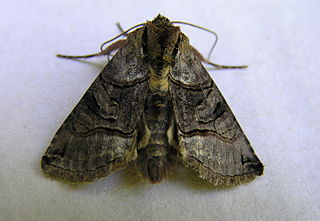
Abrostola tripartita is a moth of the family Noctuidae. It is found throughout much of the Palearctic realm including all Europe, Russia, Siberia Amur, Kyrgyzstan, and Kazakhstan.
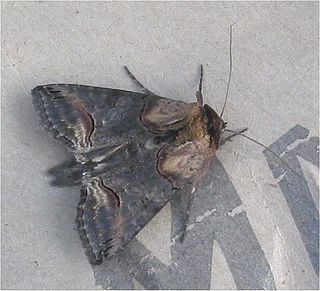
Abrostola triplasia is a moth of the family Noctuidae. It is found across the entire Palearctic realm. Subarctic territories with an average temperature of below 6 °C are an exception. In the warmest and driest regions of the Mediterranean, the Middle East, and the mountains in West and Central Asia, the species occurs only scattered or is entirely lacking.
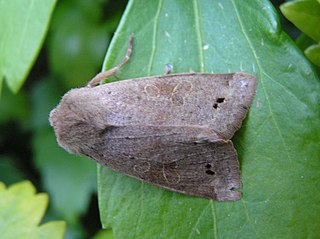
Perigrapha munda, the twin-spotted Quaker, is a species of moth of the family Noctuidae. The wings are gray, with two closely approximate and very conspicuous dark spots on the disc of the fore wings. a small dark apical mark at the costal edge and a discal spot on the fuscous hindwings. It is found in Palearctic realm.

Drymonia ruficornis, the lunar marbled brown, is a moth of the family Notodontidae. It is found in Central and Southern Europe and Anatolia.

Allophyes oxyacanthae, the green-brindled crescent, is a moth of the family Noctuidae, found in Europe. The species was described by Carl Linnaeus in his landmark 1758 10th edition of Systema Naturae.
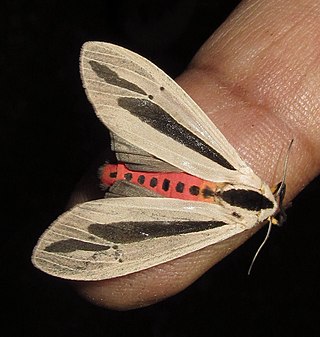
Creatonotos gangis, the Baphomet moth or Australian horror moth, is a species of arctiine moth in South East Asia and Australia. It was described by Carl Linnaeus in his 1763 Centuria Insectorum.
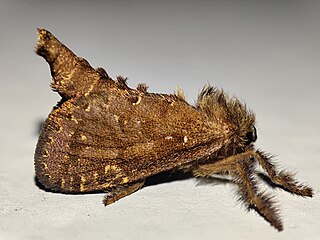
Palpifer taprobanus is a moth of the family Hepialidae. It was described by Frederic Moore in 1887 and is found in Sri Lanka.
Creatonotos interrupta is a moth of the family Erebidae. It was described by Carl Linnaeus in his 1767 12th edition of Systema Naturae. It is often listed as a synonym of Creatonotos gangis, but the identity is unclear.

Episcepsis sixola is a moth of the family Erebidae. It was described by William Schaus in 1910. It is found in Costa Rica.

Spilosoma curvilinea is a species of moth of the family Erebidae. It was described by Francis Walker in 1855. It is found in Cameroon, Republic of the Congo, Democratic Republic of the Congo, Ghana, Ivory Coast, Kenya, Nigeria, Senegal, Sierra Leone, Sudan, Tanzania, the Gambia and Uganda.
Aithorape albicostata is a moth of the family Megalopygidae. It was described by Walter Hopp in 1927. It is found in Trinidad, Brazil and Paraguay.
Aithorape longanella is a moth of the family Megalopygidae. It was described by Walter Hopp in 1927. It is found in Peru.
Aithorape spinulata is a moth of the family Megalopygidae. It was described by Walter Hopp in 1927. It is found in Peru.
Aithorape analis is a moth of the family Megalopygidae. It was described by Walter Hopp in 1930. It is found in Brazil.
Aithorape frontalis is a moth of the Megalopygidae family. It was described by Schaus in 1920. It is found in Guatemala.

Aithorape roseicornis, Dognin's satin, is a moth of the Megalopygidae family. It was described by Paul Dognin in 1899. It is found in Colombia, Ecuador and Peru, where it inhabits rainforests and cloudforests at altitudes between 200 and 1,200 meters.
Hysterocladia mirabilis is a moth of the Megalopygidae family. It was described by Schaus in 1905. It is found in Colombia.
Macara purens is a moth of the Megalopygidae family. It was described by Schaus in 1905. It is found in French Guiana.











